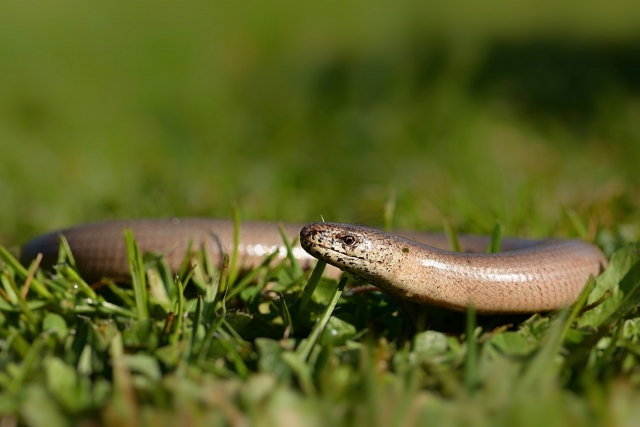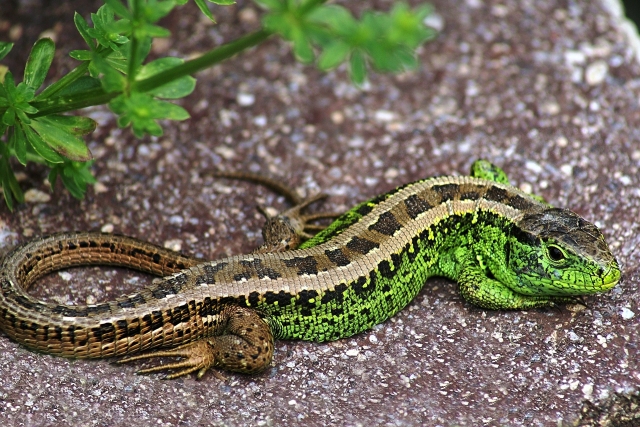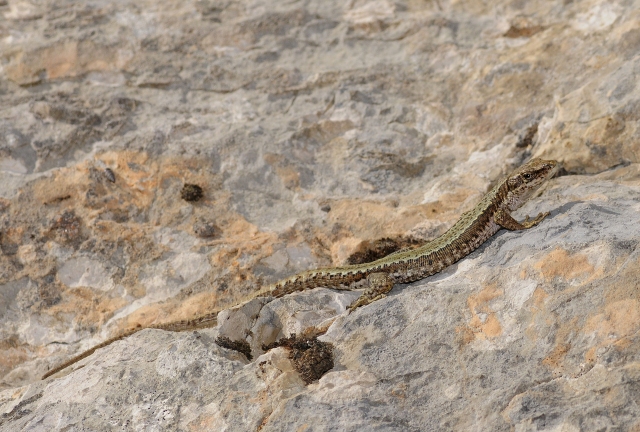Florian Heigl
Austrian Citizen Science Conference 2024
From 3 - 6 April 2024, the European and Austrian Citizen Science Double Conference took place at BOKU University in Vienna. More than 500 participants came together under the motto "Change". Change can be seen as positive by one group and negative by another. Consequently, different perspectives on a particular change can lead to completely different conclusions. The aim of the conference was to explore these different approaches to the topic of "change" from a wide range of perspectives in the field of citizen science and participatory research. The aim was to discuss both the active, transformative change initiated by citizen science as well as the observation of change identified by citizen science in various disciplines and by various interest groups. In addition, the potential of citizen science as a changemaker in research and society should be emphasised.
Four submissions from the Roadkill project were accepted by the Conference Programme Committee and we were able to present a talk and two posters at the conference as well as a market stand at the Citizen Science Day at the Natural History Museum Vienna.
We have uploaded both posters (in German) to Zenodo for easy reading.
Poster 1: Regelmäßiges Monitoring vs. Zufallsmeldungen in Bezug auf landschaftliche Einflüsse
Poster 2: Die Rolle der DNA-Analyse bei der Identifizierung von Roadkills
Awards
Thanks to the great cooperation of citizen scientists and scientists, we have succeeded in winning awards:
- 2023: Honorary Mention within the European Prize for Citizen Science
- 2023: BOKU Talent Award for Maria Peer's master's thesis, which she carried out as part of the Roadkill project.
- 2018: Nomination for the Austrian Federal Animal Protection Award.
- 2017: BOKU Sustainability Award 2017 "Light of the Future" in the category "Exchange with Society" for the Roadkill project.
- 2016: Listing of the Roadkill project as an exemplary project for environmentally friendly mobility by VCÖ.
- 2013: Pioneer of the Open Dialogue as part of the Alpbach Technology Talks
A description of the roadkill reports from 2014-2020
Abstract of the article: Data on road-killed animals is essential for assessing the impact of roads on biodiversity. In most European countries data on road-killed huntable wildlife exists, but data on other vertebrate species (e.g. amphibians, reptiles, small mammals) is scarce. Therefore, we conducted a citizen science project on road-killed vertebrates as a useful supplement to data on huntable wildlife collected by public authorities. The dataset contains 15198 reports with 17163 individual road-killed vertebrates collected by 912 participants. The reports were made in 44 countries, but the majority of data was reported in Austria. We implemented a data validation routine which led to three quality levels. Reports in quality level 1 are published via GBIF, reports in quality level 2 via Zenodo and reports in quality level 3 were deleted. The dataset is relevant for the scientific community studying impacts of roads on fauna as well as for those who are responsible for road planning and implementing mitigation measures.
More on this also in our blog (in German): https://www.citizen-science.at/blog/wie-werden-roadkill-meldungen-erhoben-und-kontrolliert-ein-neuer-fachartikel
You can find the full text of the original article here: https://www.nature.com/articles/s41597-022-01599-6
Forum Citizen Science 2022
"Global - Regional - Local: with Citizen Science for the UN Sustainable Development Goals" - this was the motto of the Forum Citizen Science 2022, which was organised by Bürger schaffen Wissen in cooperation with Bonn-Rhein-Sieg University of Applied Sciences in Sankt Augustin on 12 and 13 May 2022. We presented our engagement of the past seven years in the animal group of amphibians in a poster at this conference:
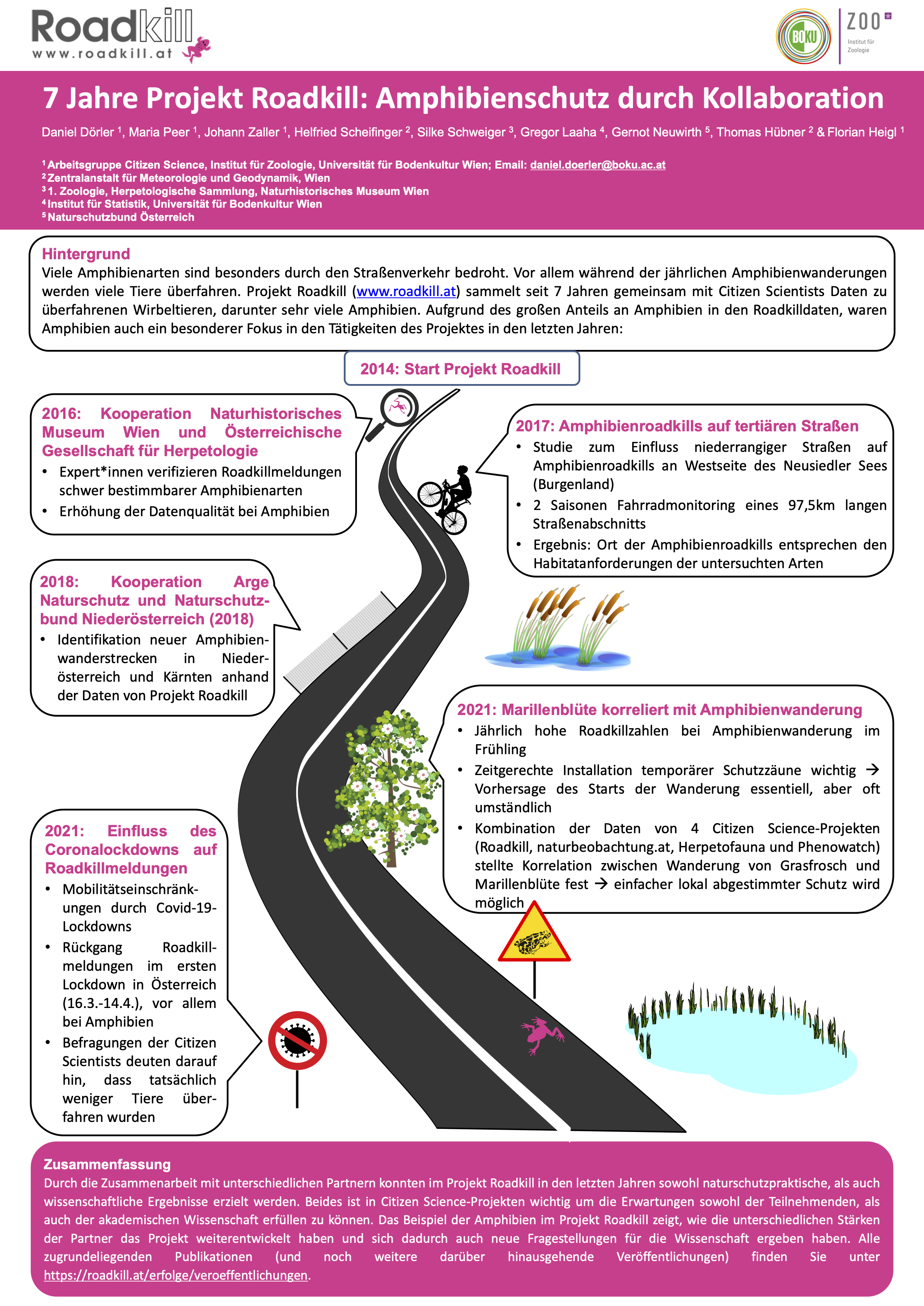
Engaging Citizen Science Conference in Aarhus
The "Engaging Citizen Science Conference" took place at Aarhus University from 25-26 April 2022, opening the international Citizen Science conference series. We were also present and reported there in the form of a poster from our latest paper on the decline in roadkill reports during the first COVID 19 lockdown:
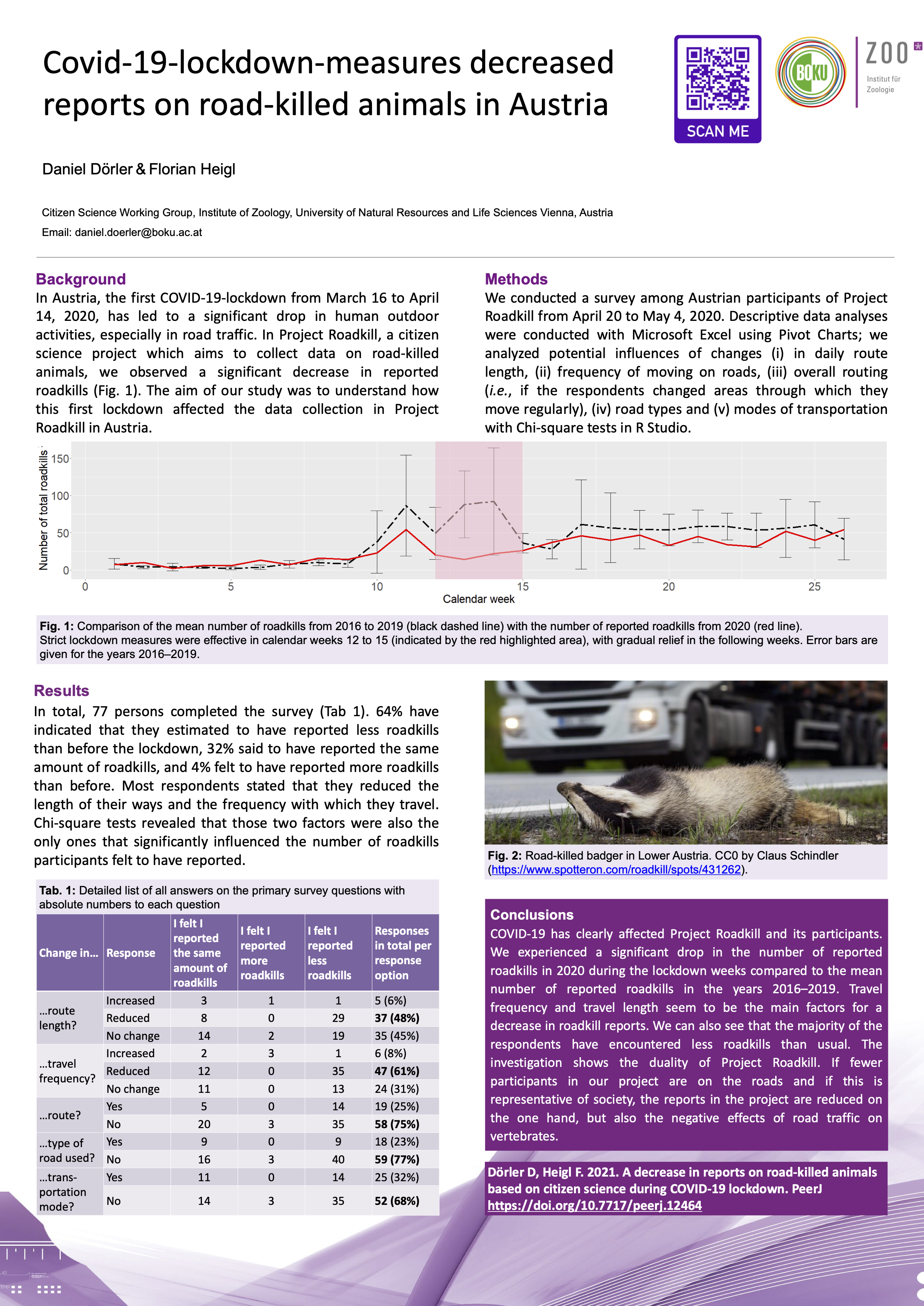
European pond turtle
Description
The European pond turtle reaches a dorsal carapace length of less than 12 cm and more than 20 cm, respectively, depending on subspecies and sex, with northern and eastern subspecies generally growing larger than southern ones. Adults exhibit marked sexual dimorphism, with females growing larger than males, their weight usually ranging from 400 to 700 g. However, in exceptional cases a weight of up to 1500 g can be reached. The coloration of the animals is also very variable. Certain pattern elements can be typical for individual subspecies. The often dark, brown or black dorsal carapace may bear a pattern of fine yellow dots or lines, often radiating from a center on the individual shields. However, there are also forms with dark markings on a light background. The ventral carapace (plastron) may be uniform yellow, mottled cloudy, speckled, dark, or even completely black. However, it is usually distinguished by a black center. The limbs and neck are dark brown to black in color and often have yellow markings as well.
The carapace of the European pond turtle is oval and rather flat; females have a slightly more convex carapace than males. The ventral carapace and dorsal carapace are joined in the area known as the bridge by a flexible layer of cartilage and elastic, membranous tissue. The middle suture of the ventral carapace develops into a hinge in older animals, allowing the anterior plastron lobe some mobility.
The limbs and tail are covered with coarse scales, and the skin of the head and neck is smooth. Behind the head, which is wider than the neck, a fold of skin can be seen that forms a pocket-like covering when retracted. The anterior end of the head is acute-angled when viewed from above, and the jaws bear edentulous sharp horny edges. The eyes, located laterally in the front of the head, have a round pupil. Eye coloration can vary by sex: adult males have a reddish iris in some subspecies, especially the nominate Emys orbicularis orbicularis, but most often they have a brownish iris coloration. The iris of females, however, is yellow in most cases.
There are webbed toes between the five toes of the front legs and the four of the hind legs. All toes are also provided with a claw, whereby especially the front claws are clearly more curved in the males. The European pond turtle belongs to the long-tailed turtle species. This is especially pronounced in hatchlings, but even in adults the tail still reaches the length of half the carapace. In males, the root of the tail is thickened, and the cloaca is clearly located behind the edge of the dorsal carapace.
Habitat
The European pond turtle lives in still or slow-flowing waters, in the shore area of inland lakes, in ponds, ditches and the oxbows of rivers. In the south of the range, streams are also colonized. Along the Mediterranean coast it penetrates into the brackish zones of river mouths. Heavily weedy, nutrient-rich waters with muddy bottoms are preferred. It can even be found in muddy cattle troughs on occasion. Branches sticking out of the water, trees felled by beavers, root stumps and other dead wood are needed for sunbathing, also grass stumps, old nests of water birds and the like are visited for this purpose. Also important are shallow still water zones that are warmed by the sun.
In Austria, the last naturally reproducing population is found in the Danube floodplains east of Vienna, as well as some released specimens on the Wienerberg in the municipal area of Vienna.
The text is a translation of an excerpt from Wikipedia (https://de.wikipedia.org/wiki/Europäische_Sumpfschildkröte). On wikipedia the text is available under a „Creative Commons Attribution/Share Alike“ licence. Status: 26 May 2021
Slowworm
Description
Slowworms have an elongate body, circular in cross-section, without extremities, and reach a total length of up to 57.5 cm. Most adults observed, however, tend to be between 40 and 45 cm long, with up to 22 cm of this being accounted for by the snout-vent section, and the remainder by the tail. The rather small, high head merges abruptly into the torso. The tail, which ends in a horny tip, is also not separated from the torso and is often somewhat longer than the latter. Due to the fact that the animals can easily drop their tail at several predetermined breaking points, however, quite a few specimens no longer have a completely preserved tail. Unlike true lizards, the tail section does not grow back after an autotomy. Only a very short, hemispherical stump forms. In some populations, more than half of the adults no longer have a complete tail. Therefore, for field biology body measurements, the snout-vent length - from the tip of the snout to the cloaca - is preferred. The cloaca has a transverse cleft in the slowworm.
The skin surface consists of smooth, round to hexagonal horny scales overlapping like roof tiles, which are approximately the same shape on the upperparts and underparts of the body. Several longitudinal rows of these are also present on the ventral side, and the scales there are only slightly smaller than on the dorsal side. In the middle of the torso, one transverse row includes 24 or 26 scales. In total, the torso has 125 to 150 transverse rows of scales and the tail has another 130 to 160 rows. Beneath the scales are bony platelets (osteoderms), which allow slowworms to crawl much more stiffly and clumsily than snakes. The head scaling resembles that of lizards; the pileus shields bordering the head posteriorly are relatively large. However, the ear openings are usually completely hidden under the scales. The relatively small eyes have movable, closable lids (in snakes these are fused) and round pupils. The rather short tongue is broad-two-lobed and does not run out into fine points. To tongue, i.e., to take in odorants, slowworms must open their mouths slightly, as they do not have an upper lip gap like snakes. The pointed little teeth, some of which are quite loose, are curved backward; there are 7 to 9 of them in the premaxilla, 10 to 12 in the maxilla, and 14 to 16 in the mandible. In advanced age, slowworms have often lost part of their teeth.
The extremities are completely degenerated; only in embryos are anterior leg rudiments initially detectable, but these later disappear. In adults, only small remnants of a shoulder and pelvic girdle on the spine indicate phylogenetic descent from leg-bearing ancestors.
colouration and patterns
As juveniles slowworms have a very contrasting coloration and patterning. On the silvery-white or golden-yellow upperpart a black line ("dorsal line"; sometimes this can be interrupted or missing completely) runs from the back of the head - there broadened or forked - to the tip of the tail. The flanks, like the belly, are black and thus sharply set off from the upperpart. With age, the black may lighten to gray, blue or brownish tones. The iris is dark brown in the young.
The bodies of adults have a variable ground coloration of brown, gray, yellow, bronze, or copper tones above. This coloration is interspersed with more or less distinct dark spots and lines or is also featureless. Sometimes they also show the dorsal line of the juvenile phase, although this has now broadened. On the sides, there are often four to six dark longitudinal stripes, which in turn may merge with each other, creating a color separation between the dorsal side and the flanks. The ventral side is lead-gray to black. Due to diverse patterns of dots and lines, various varieties of the slowworm have been described and named; however, these have no taxonomic significance.
Habitat
In terms of habitat requirements, the slowworm is considered eurytopic, i.e. it uses a variety of different biotopes without specialization. It is often found in dense deciduous forests and their edges, hedgerows, partially drained upland moors and moor edges, and on shrub-lined bristly grass lawns, as well as in heath areas, on fallow land, meadows, along railroad embankments, log jams, roadsides, in parks and near-natural gardens on the edges of settlements; even dense coniferous forests with only small areas of sunlight are sometimes sufficient for it. The animals prefer herbaceous vegetation rich in cover and some soil moisture; in terms of ambient temperature, they are slightly less heat-dependent than many other reptiles. In keeping with its broad ecological amplitude, the slowworm can co-occur with species of more humid areas (such as the common lizard and European adder) as well as those of more arid habitats (such as the smooth snake and sand lizard).
It likes to use sheltered dry sunny places, for example on dead wood, dark humus soil and peat or on old grass bulbs, which are in the vicinity of somewhat wetter, but also easily warmable, not too shady hiding places (burrows, cavities under tree roots, lying wood, stones, plastic film or sheet metal, rock crevices, moss cushions, also leaf and compost heaps or firewood piles). In particularly favorable hiding places, several animals often find themselves at the same time.
The text is a translation of an excerpt from Wikipedia (https://de.wikipedia.org/wiki/Blindschleiche). On wikipedia the text is available under a „Creative Commons Attribution/Share Alike“ licence. Status: 26 May 2021
Sand lizard
Description
In German-speaking countries, sand lizards reach total lengths of about 24 cm. Particularly large animals here have snout-vent lengths of about 9.5 cm and tail lengths of about 14 cm. The largest known snout-vent length of 11.5 cm comes from a sand lizard from the Caucasus. In general, females have longer trunks, while males have longer heads and slightly longer tails. Compared to the common lizard and the European wall lizard, the animal appears plumper and much stronger. The sides of the snout are steep and high, ending blunted forward. The top of the head is flattened and separated from the sides by a ridge extending from the eyes to the nostrils. The back of the head is slightly broader than the neck and therefore set off from it. The tail is much higher than broad at its root and gradually tapers; the tip is not extended very long. (A regrown, regenerated tail is usually much shorter and less marked).
Coloration and markings are highly variable depending on the individual, sex, age stage, and season (males!). Often a "ladder-like" pattern of markings consisting of light lateral lines (parietal bands) and dark brown "transverse sprouts" (dorsal spots) with brown interspaces runs down the middle of the back and tail. In the middle as well as laterally over the dorsal spots mostly whitish, interrupted longitudinal lines (occipital line as well as parietal lines) run. The ground color of the upper head, tail and limbs is also brownish and the spots of the flanks are also white-cored. During the mating season (until June/July), the males show green colored head, rump and belly; especially in southwestern Germany, there are also animals that appear almost entirely green. Red-backed specimens are another distinctive feature. The underparts are yellowish and spotless in females, green with black spots in males. Juveniles have brownish coloration, often with conspicuous eye spots on the back and sides.
Habitat
Sand lizards are anthropogenically oriented species with respect to their habitat structures. They inhabit lean biotopes such as dry forest edges, railroad embankments, heathlands, dunes, quarries, gravel pits, wildlife gardens, and similar habitats with an alternation of open, loosely vegetated sections and more densely vegetated areas. In cooler areas, occurrences are limited to sites favored for warmth. Elements such as dead wood and old grass are also important.
The text is a translation of an excerpt from Wikipedia (https://de.wikipedia.org/wiki/Zauneidechse). On wikipedia the text is available under a „Creative Commons Attribution/Share Alike“ licence. Status: 26 May 2021
European green lizard
Description
It is a large, but still quite slender looking lizard with a pointed head and a, especially in males, quite long tail. Its dimensions can reach 1.6 to 2.3 times the snout-vent length, which is up to 13 cm. However, the maximum total length is often difficult to quantify, since many older animals no longer have an intact tail, but have lost and (incompletely) regenerated it in the meantime in contact with predators or in mating fights. However, up to about 40 cm total length is reached. The extremities are relatively long in relation to the body.
The back and large parts of the body are light to dark green in both sexes. However, the green coloration develops gradually during the first years of life; the young show brown tones. While the slightly more robust-looking, large-headed males usually have small black speckles, sometimes arranged in an ornamental pattern, on the green ground color, the females often have a patterns with dark markings arranged in rows and whitish-yellow lines that may merge to form longitudinal bands. However, depending on the region and season, the sexes cannot always be distinguished by markings. The belly and throat are spotless white, greenish, or yellow in color. With the first molt after hibernation, the chin, throat and neck region become greenish blue to "cornflower blue" in both males and some females. This "mating dress" appears more contrasting and colorful in the male.
Habitat
European green lizards prefer sun-warmed, south/southwest/southeast exposed terrain slopes with a sufficient degree of moisture and a mixture of open structures and mosaic vegetation. Particularly suitable are, for example, drier forest edges, grassy vineyards, semi-arid grasslands (but not shrubless dry grasslands!), broom and steppe heaths, blackberry thickets, railroad and road embankments, meadows with sloe bushes and sparse orchard meadows. In the south of the distribution area, however, the occurrences are often restricted to damp locations or mountainous regions. The diurnal animals take extensive sunbaths, especially in the morning and evening; otherwise they climb around in the plant undergrowth in search of food. In case of danger, they scurry very nimbly into protective vegetation as well as into crevices and cavities.
The text is a translation of an excerpt from Wikipedia (https://de.wikipedia.org/wiki/Östliche_Smaragdeidechse). On wikipedia the text is available under a „Creative Commons Attribution/Share Alike“ licence. Status: 26 May 2021
Horvath's rock lizard
Description
The total length of this small, slender lizard species is a maximum of 18 cm, the snout-vent length is about 6.5 cm. In appearance, the species resembles the European wall lizard (Podarcis muralis). The collar closes smoothly to the back. The dorsal scales are relatively large, roundish to hexagonal, flat and not keeled. On the middle of the back they are arranged in distinct transverse rows, on the flanks more irregularly. The head, back and upper side of the tail are light brownish, gray-greenish to whitish-gray. In oblique light, the species may have a greenish iridescence. Beginning at the nostril, a broad, dark to reddish-brown longitudinal band extends over the temporal region and the upper half of the flanks, the upper edge of which is distinctly serrated. This band also extends over the sides of the tail, where it forms characteristic rhomboids strung together. Occasionally the pale dorsum is patternless, but usually it is covered with numerous small dark spots. Relatively often there is a narrow brown line on the middle of the back, but it may be incompletely developed. The throat region is whitish-gray, the ventral side straw to greenish-yellow colored. The underpart is unspotted, only on the outer row of the ventral shields there may be black or even rust-colored spots. Juveniles closely resemble adults in coloration and markings, but have conspicuously chip-green or greenish-gray tails.
Habitat
The Horvath's rock lizard is a mountain species found from 250 m above sea level upwards. The highest occurrence is at 2000 m altitude on Visoka Ponca (Slovenia). Preference is given to damp, cool altitudes of 800-1200 m, especially stony terrain, cliffs, karst rocks, stone bridges and road embankments. They usually stay directly on rock faces, near crevices, or in scree that is sometimes overgrown with moss, grasses, and small ferns. The animals also stay on ungrouted retaining walls and in their crevice system. At lower altitudes, the species is often associated with the European wall lizard. There the well climbing species prefers smooth and steep rock surfaces, on which it still finds sufficient hold as the lighter species in contrast to the heavier European wall lizard.
The text is a translation of an excerpt from Wikipedia (https://de.wikipedia.org/wiki/Kroatische_Gebirgseidechse). On wikipedia the text is available under a „Creative Commons Attribution/Share Alike“ licence. Status: 26 May 2021







